You’d be surprised by the treasure trove of jewelry-making materials sitting right in your backyard. From the diamond mines of Arkansas to Montana’s sapphire deposits, regional sources offer gemstones you won’t find anywhere else. Local metal suppliers, recycling centers, and artisan networks provide sustainable options that’ll transform your craft while supporting your community. The question isn’t whether these materials exist locally—it’s knowing where to look.
Regional Gemstone Mines and Their Unique Offerings
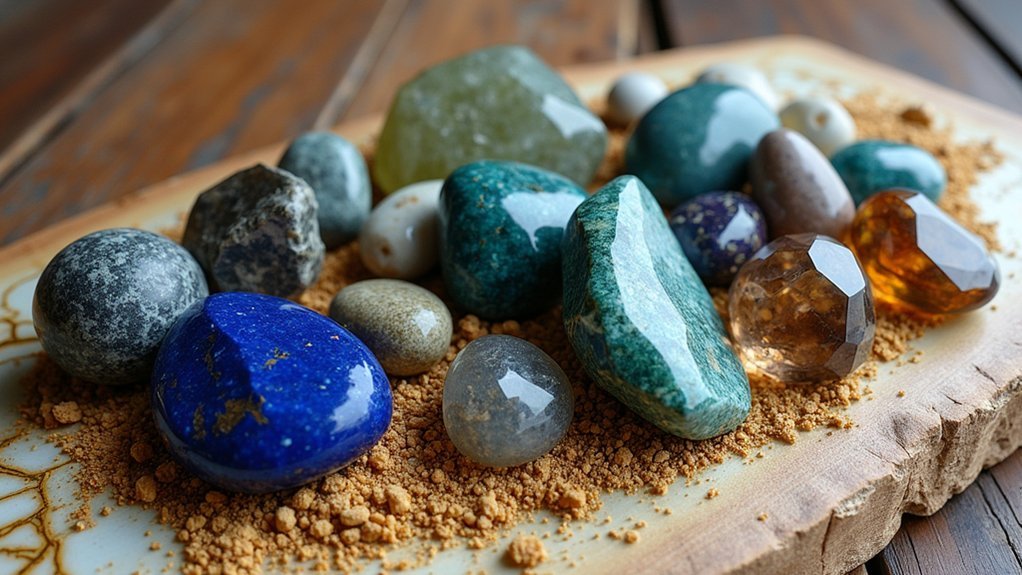
The United States harbors remarkable gemstone mines across diverse regions, each offering distinct treasures that’ll elevate your jewelry designs.
Arkansas’s Crater of Diamonds State Park lets you hunt for real diamonds you can keep, while Montana’s Yogo Gulch produces world-renowned sapphires with exceptional color and clarity.
Arkansas offers diamond hunting adventures where finders become keepers, while Montana delivers sapphires prized globally for their stunning clarity and color.
New Mexico’s regional gemstone mines yield vibrant turquoise from the Sleeping Beauty and Kingman sites, perfect for southwestern-style pieces.
The Appalachian region offers abundant garnets and semi-precious stones that attract gem hunters nationwide.
California’s San Diego County features tourmaline deposits, particularly the famous Himalaya Mine known for its color variety.
These unique offerings provide local businesses with distinctive materials that set their jewelry apart from mass-produced alternatives.
Local Metal Suppliers and Recycling Sources
While sourcing precious metals forms jewelry’s foundation, establishing connections with local metal suppliers and recycling sources can dramatically reduce costs and environmental impact.
You’ll find that local metal suppliers typically stock gold, silver, and platinum essential for high-quality pieces. Don’t overlook recycling centers where you can source recycled metals sustainably and cost-effectively.
Consider specialty suppliers offering unique materials like titanium or stainless steel for custom designs and niche markets. Local universities with jewelry programs often sell surplus materials at competitive prices.
Building relationships with these local metal suppliers provides significant advantages: better pricing, faster delivery times, and access to exclusive materials unavailable through large distributors.
This approach streamlines your supply chain while supporting your community’s economy.
Community Artisan Networks and Craft Cooperatives
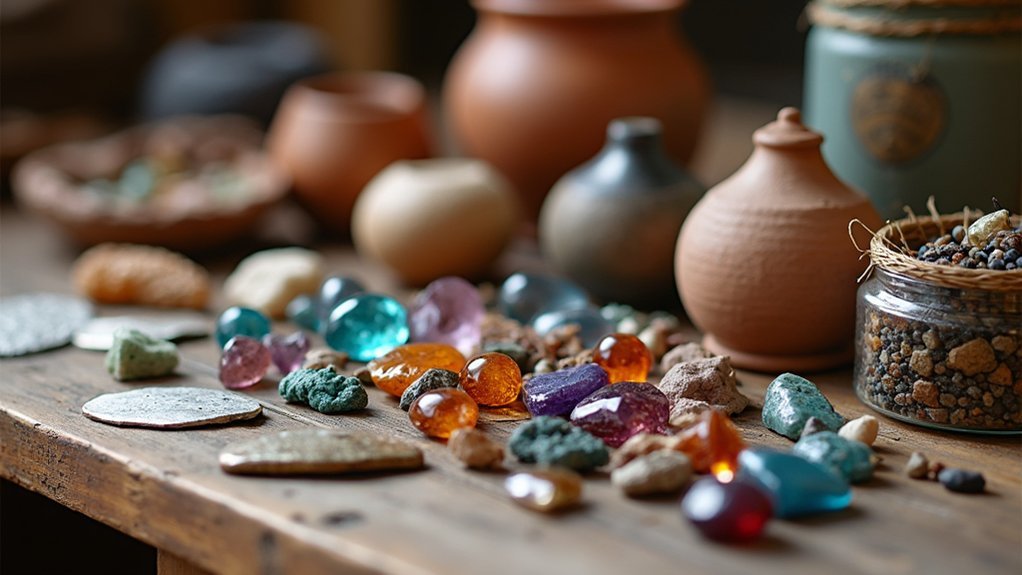
Beyond traditional suppliers, community artisan networks and craft cooperatives release access to distinctive materials that can set your jewelry apart from mass-produced pieces.
These collaborative environments connect you directly with local artisans who craft unique components and source regional materials.
You’ll discover exceptional opportunities through:
- Craft fair partnerships – Purchase handmade beads, findings, and gemstones directly from creators
- Shared workshop facilities – Access specialized tools and equipment while reducing overhead costs
- Facebook craft groups – Stay informed about regional suppliers and material availability
- Cooperative buying power – Pool resources with other jewelers for bulk purchases of premium materials
Craft cooperatives particularly excel at connecting you with ethically-sourced, culturally significant materials that add meaningful stories to your designs while supporting sustainable local practices.
Sustainable Wood and Organic Materials From Local Forests
Although traditional metal and gemstone jewelry dominates the market, you’ll find remarkable creative possibilities when sourcing sustainable wood and organic materials from your local forests.
| Material Type | Local Sources | Sustainability Benefits |
|---|---|---|
| Maple Wood | Regional forests, reclaimed furniture | Renewable, biodegradable |
| Cherry Wood | Local orchards, salvaged timber | Reduces transportation emissions |
| Walnut Wood | Native tree harvesting | Supports forest management |
| Natural Gemstones | Regional deposits, riverbeds | Eliminates mining impact |
| Plant-based Resins | Local tree saps, organic compounds | Eco-friendly alternatives |
You’ll reduce your carbon footprint while creating unique pieces that reflect regional biodiversity. Local artisans often provide reclaimed materials, adding character and history to your designs. These organic materials foster community connections and enhance your jewelry’s storytelling potential through sustainable practices.
Beach and River Stones for Natural Jewelry Elements
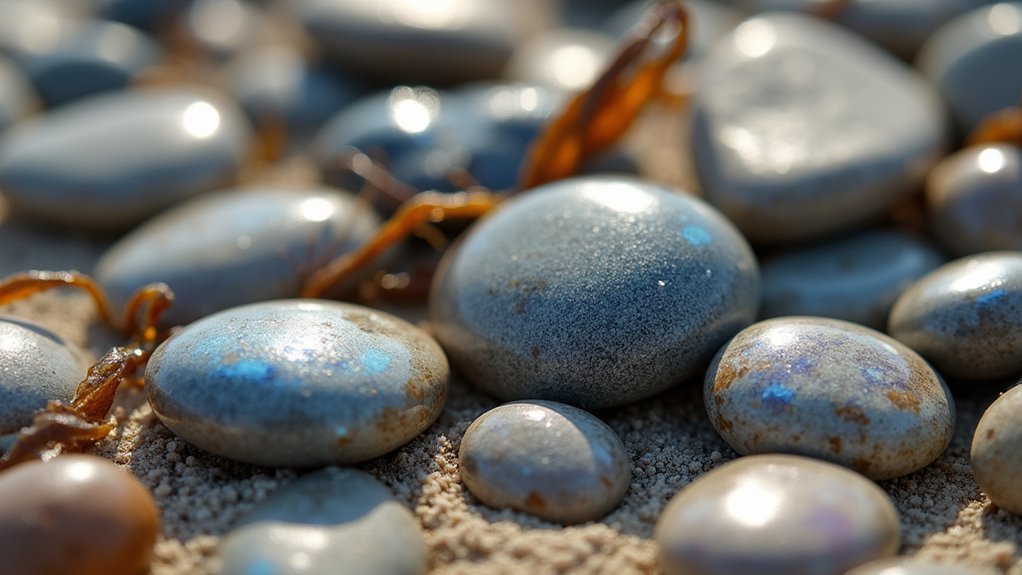
When you’re collecting beach and river stones for jewelry making, you’ll find the best specimens in areas where water naturally tumbles and polishes rocks over time.
You can gather stones directly from shorelines, riverbeds, and creek banks, but always check local regulations and obtain permission when necessary.
Once you’ve collected your stones, you’ll need to clean them thoroughly and decide whether to polish them for a refined look or preserve their natural texture for rustic designs.
Stone Collection Methods
Countless smooth stones lie waiting along coastlines and riverbeds, offering jewelers an abundant source of natural materials that cost nothing more than time and effort to collect.
These stone collection methods require strategic timing and location awareness to maximize your harvest of beach stones and river stones.
Successful collection depends on understanding natural patterns:
- Visit beaches after storms when high tides expose fresh stones and wash away sand coverings.
- Explore riverbeds during dry seasons when low water levels reveal hidden gems in rocky areas.
- Check local regulations first since some protected areas restrict removal of natural materials.
- Bring proper tools like mesh bags and knee pads for comfortable, efficient gathering sessions.
You’ll discover unique textures and colors that can’t be replicated artificially.
Preparing Natural Stones
Three essential steps transform your collected beach and river stones into polished jewelry components ready for setting or stringing.
First, you’ll clean your beach and river stones thoroughly, removing sand, algae, and debris using a stiff brush and mild soap.
Next, you’ll assess each stone’s potential by examining natural patterns, colors, and textures to determine the best jewelry application.
Finally, you’ll enhance your local stones through minimal processing—polishing rough surfaces with fine-grit sandpaper or drilling holes for stringing. This approach preserves each stone’s unique character while making them jewelry-ready.
You’ll find that agate, jasper, and quartz varieties respond particularly well to basic preparation techniques.
Processing local stones yourself promotes sustainability while creating distinctive pieces that reflect your region’s natural beauty.
Local Glass Blowers and Ceramic Artists for Custom Components
Many local glass blowers create stunning custom beads and components that’ll transform your jewelry from ordinary to extraordinary.
These skilled artisans craft one-of-a-kind pieces that you simply can’t find in mass-produced supply catalogs.
Artisan-crafted components offer distinctive character and authenticity that mass-produced jewelry supplies simply cannot replicate.
When you partner with local glass blowers and ceramic artists, you’ll discover several advantages:
- Unique custom components tailored to your specific design vision and color palette
- Reduced shipping costs and faster delivery times for quicker project completion
- Learning opportunities through workshops where you’ll master new techniques
- Community support that strengthens relationships with local artisans and small businesses
Ceramic artists also offer handmade clay pendants and charms that bring rustic, artisanal quality to your designs.
Collaborating with these local artisans guarantees your jewelry stands out while supporting your community.
Regional Specialty Suppliers for Tools and Equipment
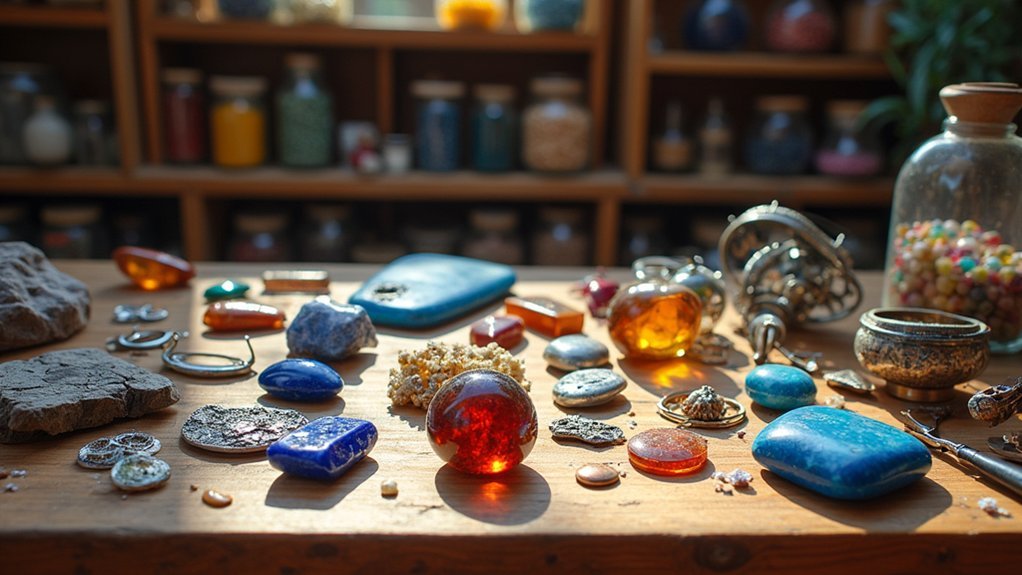
While online retailers dominate the jewelry supply market, regional specialty suppliers offer distinct advantages that’ll elevate your craft and streamline your workflow.
You’ll discover unique gemstones sourced from nearby mines and specialized tools tailored for specific techniques like wire wrapping or casting. Local specialty suppliers stock equipment that complements regional jewelry-making styles, ensuring you have access to materials reflecting your area’s cultural heritage.
These partnerships deliver faster shipping times and reduced costs, keeping your production schedule consistent. You’ll avoid lengthy waits for essential tools and equipment while building valuable community connections.
Engaging with regional suppliers provides insights into emerging regional trends and innovative techniques, helping you stay ahead of local market demands and expand your creative possibilities.
Estate Sales and Antique Dealers for Vintage Materials
You’ll discover treasure troves of vintage materials by actively seeking out estate sales in your area and building relationships with reputable antique dealers.
These sources provide access to unique vintage components like old watch parts, antique chains, and period-appropriate findings that you can’t find through traditional suppliers.
Transform discovered antique jewelry pieces by carefully dismantling them to salvage precious metals, gemstones, and distinctive design elements for your contemporary creations.
Finding Estate Sales
Where can you discover the most authentic vintage jewelry materials at prices that won’t break your budget? Estate sales offer jewelers exceptional opportunities to source unique components and vintage materials at negotiable prices.
You’ll find everything from gemstones to precious metals that can transform your designs.
To locate these treasure troves, focus on these key resources:
- Local classifieds – Check newspapers and community bulletins for upcoming sales
- Social media groups – Join local estate sale communities and Facebook marketplace groups
- Estate sale websites – Browse EstateSales.net and similar platforms for scheduled events
- Antique dealer networks – Connect with dealers who attend sales and can alert you to valuable finds
Scout listings beforehand, arrive early, and bring appraisal knowledge to identify quality vintage materials effectively.
Vintage Component Sources
Beyond simply attending estate sales, building relationships with antique dealers expands your access to premium vintage components year-round.
These established professionals curate collections of old gemstones, ornate metal findings, and intricate clasps that add distinctive character to contemporary designs. Unlike one-time estate sales, antique dealers maintain ongoing inventory, allowing you to source materials consistently for your creative projects.
Both estate sales and antique dealers welcome negotiations, helping you secure vintage components below retail pricing.
You’ll discover these opportunities through local online classifieds and social media marketplace searches. The historical provenance of these materials enhances your jewelry’s storytelling appeal, attracting customers who value craftsmanship and heritage.
This sourcing strategy transforms ordinary pieces into conversation starters with authentic vintage charm.
Antique Jewelry Repurposing
While sourcing individual components offers flexibility, repurposing complete antique jewelry pieces reveals even greater creative potential for your designs.
Estate sales and antique dealers provide access to vintage jewelry containing high-quality materials no longer in production, enabling you to craft exclusive designs that stand apart from mass-market offerings.
Repurposing these treasured pieces transforms old into new while preserving their historical character:
- Extract precious metals from worn settings to create contemporary frameworks
- Salvage gemstones from damaged pieces for incorporation into modern designs
- Reimagine vintage elements by combining multiple antique pieces into unified creations
- Preserve ornate details by integrating decorative elements into new settings
This sustainable approach reduces waste while offering customers meaningful pieces with authentic stories and unmatched character.
University Programs and Educational Institutions for Specialized Resources
Educational institutions offer jewelers access to specialized resources that aren’t typically available through commercial channels.
University programs like those at Fashion Institute of Technology connect you with local suppliers through established partnerships, giving you direct access to specialized materials and tools.
Community colleges often host jewelry-making programs that collaborate with local artisans, allowing you to source materials directly from nearby suppliers.
The Gemological Institute of America offers workshops connecting students with regional gem dealers, enhancing your practical experience.
You’ll find student-run studios at various universities that utilize local materials, letting you work with regional gems and metals while supporting local businesses.
University-sponsored craft fairs expose you to unique materials from nearby suppliers, fostering valuable community relationships that extend beyond your educational experience.
Frequently Asked Questions
Where Do Jewelers Get Their Inventory?
You’ll source inventory from local suppliers offering metals and gemstones, attend craft shows for unique materials, visit jewelry supply stores for tools, collaborate with local artisans, and explore online platforms connecting you with regional suppliers.
Is It Cheaper to Buy From a Local Jeweler?
You’ll often find better deals at local jewelers since they’ve got lower overhead costs, no shipping fees, and they’ll offer loyalty programs that big chains don’t provide.
What Materials Are Used in Jewelry?
You’ll find jewelry made from precious metals like gold, silver, and platinum, plus gemstones including diamonds and sapphires. Jewelers also use pearls, semi-precious stones, resin, wood, and various findings for assembly.
Where Do Jewelry Brands Get Their Jewelry From?
You’ll find jewelry brands source materials from local suppliers, international wholesalers, specialized manufacturers, mines, cooperatives, trade shows, craft fairs, and online platforms like Maker’s Row to create their distinctive pieces.
In Summary
You’ll discover that sourcing materials locally transforms your jewelry-making practice while supporting your community’s economy. Whether you’re mining regional gemstones, partnering with local artisans, or repurposing vintage components from estate sales, you’re creating unique pieces with authentic stories. Don’t overlook sustainable options like recycled metals and organic materials from nearby forests. By building relationships with local suppliers, glass blowers, and educational institutions, you’ll develop a reliable network that enhances your craft’s authenticity and sustainability.

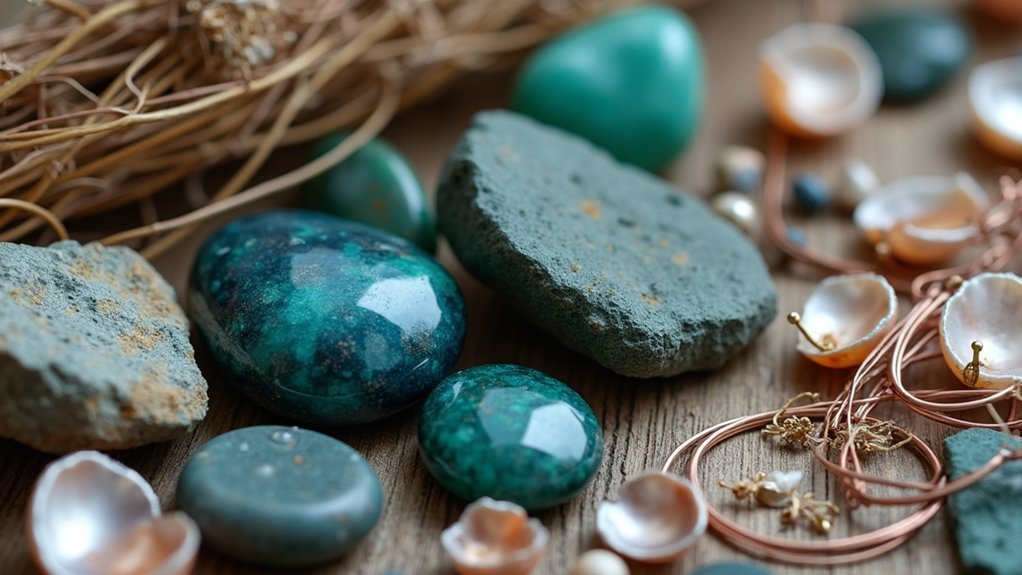



Leave a Reply